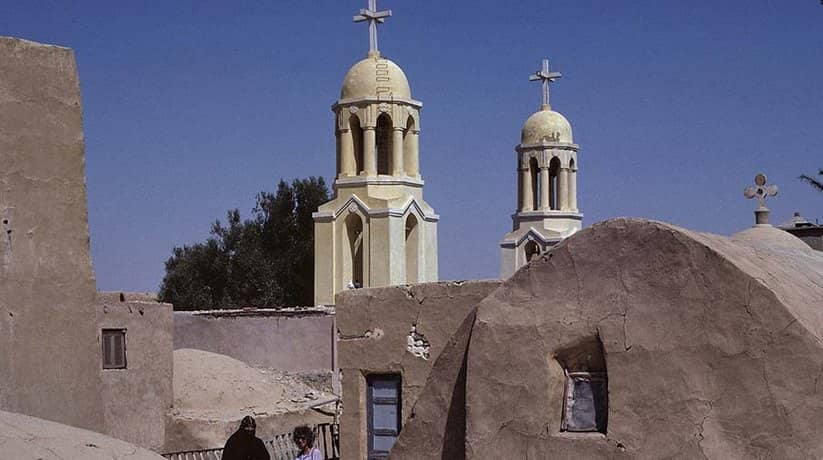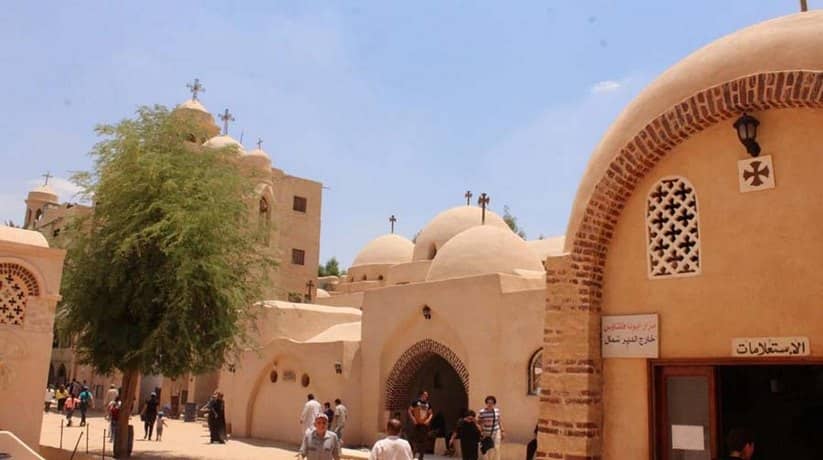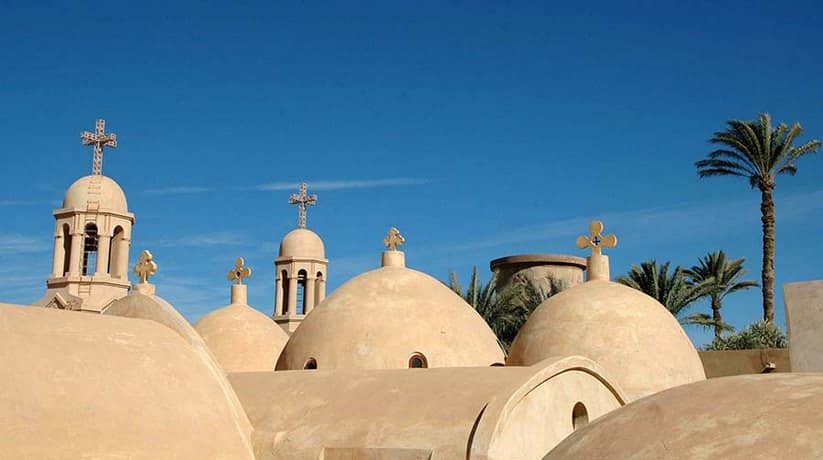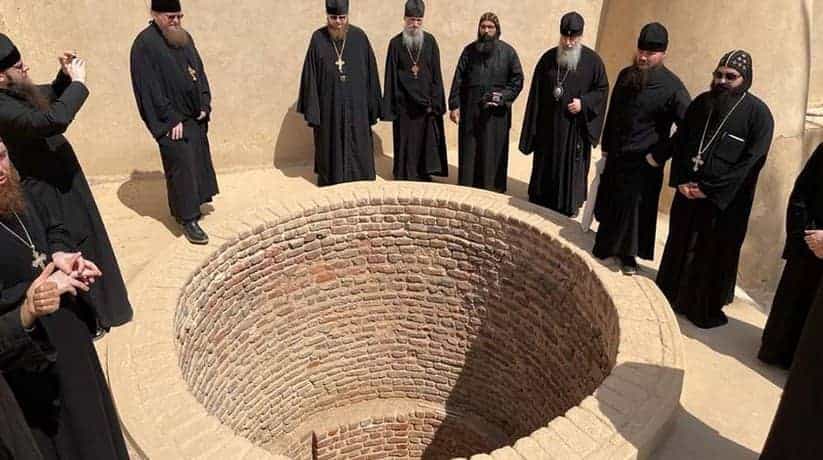Baramous Monastery Egypt tours, booking, prices, reviews
Baramous Monastery Egypt, also known as Paromeos Monastery, is a Coptic Orthodox monastery. The monastery located in Wadi El Natrun (the Nitrian Desert). It is in Beheira Governorate, Egypt. In fact, it is the most northern monastery among the four current Monasteries of Scetes. Baramous Monastery is about 9 km northeast of the Monastery of St. Bishoi. The name Paromeos derived from the Coptic Pa-Romeos, which means that of the Romans. The monastery dedicated to the Virgin Mary and carries her name. In fact, the monastery is probably the oldest among the four existing Monasteries of Scetes.
Baramous Monastery founded on 335. By St. Macarius the Great. The name Pa-Romeos or that of the Romans may refer to Saints Maximus and Domitius. They are the children of the Roman Emperor Valentinian I. They had their cell at the place of the modern monastery. According to Coptic tradition, the two saints went to Scetes during the time of St. Macarius the Great. He tried in vain to dissuade them from staying. Nevertheless, they stayed and attained perfection before dying at a young age. A year after their departure, St. Macarius the Great consecrated their cell by building a chapel. He told the monks “Call this place the Cell of the Romans”.
Further details about Paromeos Monastery:
Another theory holds that the name refers to the Roman Emperors Arcadius and Honorius, disciples of St. Arsenius. The latter was himself a Roman monk who established himself in Scetes. It is possible that the two emperors had visited their teacher in his seclusion. Thus, they gave to the monastery its name. Following the destruction of Baramous Monastery in 407 by the Berbers and the Bedouins, St. Arsenius returned to rebuild it. However, following a second raid also by the Berbers in 410, he retired to Troe. Now a neighborhood of Cairo known as Tura, where he died.
Beside St. Macarius the Great and St. Arsenius, other saints of the fourth and fifth century resided in the Baramous Monastery. They are St. Isidore, and St. Moses the Black who martyred at the raid of 407 A.D. Pope Shenouda I of Alexandria (859-880) built walls around the Monasteries. In fact, it was because of the attacks by the Berbers and the Bedouins. The walls height varies between ten and eleven meters, and their widths are about two meters. They also covered with a thick layer of plaster. During the first half of the fifteenth century, the historian Al-Maqrizi visited the monastery. He was responsible for identifying it as that of St. Moses the Black.
More details about the Monastery:
At that time, he found it to have only a few monks. Though the community of monks was fairly insignificant during the Middle Ages. Baramous Monastery apparently supplied one monk to the patriarchal throne in 1047. He was Pope Christodolos of Alexandria, who proved to be a man of great holiness. The monastery also supplied two monks in the seventeenth century to the patriarchal throne. They are Pope Matthew III of Alexandria and Pope Matthew IV of Alexandria. The monastery also produced many outstanding theologians. They are Father Naum, and Father Abdel Massih ibn Girgis el Masoudi. Both are of the nineteenth century.
Today, Baramous Monastery still preserves much of its ancient character. It has five churches. The oldest church dedicated to the Virgin Mary and contains the relics of St. Moses the Black. It is indeed oldest church in Scetes still in existence, dating back to the sixth century. The second church dedicated to St. Theodore of Amasea. The third to St. Georges, the fourth to St. John the Baptist, and the fifth to Archangel Michael. The walls built by Pope Shenouda I of Alexandria are still standing today. The monastery also contains a keep, a tower, two refectories, and a guest house.
Further details about Baramous Monastery Egypt:
About two and a half kilometers northwest of this monastery, there is also the limestone cave. It is of the late Pope Cyril VI. Marked by twelve wooden crosses, it known as the Rock of Sarabamun and has become a popular place of pilgrimage. An iron lattice-work protects the entrance to the site. Within, the one room cave is spacious. It adorned with many pictures and icons of Pope Cyril VI. In the desert about the monastery there are also several caves. They apparently continue to inhabit by hermits. Under Pope Shenouda III, many recent renovations performed at the monastery. An asphalt road to the monastery built, and there are several major cultivation projects.
Besides, six water pumps, a sheepfold, a hen-house and two generators added. Together with the construction of new residential cells both inside and outside the monastery proper. There is now a clinic and a pharmacy to serve the monks. There is also a spacious retreat center for conferences and a large, two story guesthouse that opened in January 1981. This monastery surrounded by an enclosure wall that was perhaps a somewhat late addition during the ninth century. Within the old monastery, archaeologists discovered the remains of a square structure. They measuring some sixteen meters square. It was in the southeastern corner of the site.
More details about Baramous Monastery Egypt:
Though its original purpose was at first unclear. It determined to have most likely been a defensive tower. Or keep that may have stood some twenty-five meters in height. However, pottery from the 4th or early 5th century found on the site. It suggested that this tower built very early for monastic purposes. Particularly with regards to what was probably a fairly small community of monks. It suggested that this may have originally built as a Roman military structure. It was to defend the Nitrian Desert and its salt production. Then, after abandoned during the fourth century, it put to use by newly arrived anchorites.
In 1998, excavations uncovered a structure that proved later to be that of a church immediately north of the tower. The walls of the nave made from poor quality. They improvised masonry that suggest that the church perhaps rebuilt hastily after destroyed. The actual sanctuary of this church is of better quality. It apparently reconstructed somewhat later, perhaps at the end of the ninth or the beginning of the tenth century. The altar, which fairly well preserved, sits atop a one step high podium.
















